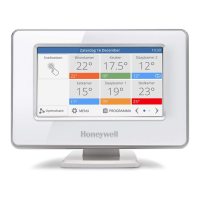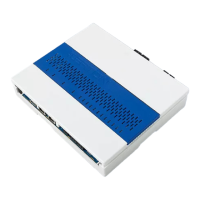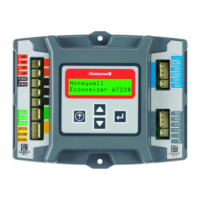PNEUMATIC CONTROL FUNDAMENTALS
ENGINEERING MANUAL OF AUTOMATIC CONTROL
82
18
16
14
12
10
8
6
4
2
0
RELAY OUTPUT (PSI)
RELAY INPUT
PSI
KNOB SETTING (%)
100
80
60
40
20
0
0 246810121416 18
C1097
7
HESITATION RELAY
The hesitation relay is used with a pneumatic actuator in
unit ventilator applications. The output pressure goes to
minimum whenever the input pressure is below the minimum
setting. Figure 49 shows a graph of the output of a hesitation
relay as controlled by the relay knob settings (piloted from the
thermostat).
M
MB
M
P
B
M
DA ROOM
THERMOSTAT
HESITATION
RELAY
DAMPER
ACTUATOR
C2346
Fig. 49. Hesitation Relay Output Pressure
as a Function of Knob Setting.
The hesitation relay has an internal restrictor. Figure 50
shows a typical application of a hesitation relay and a
pneumatic damper actuator. When the thermostat branchline
pressure reaches 1.5 psi, the relay output goes to its preset
minimum pressure. When the branchline pressure of the
thermostat reaches the setting of the hesitation relay, the
thermostat controls the damper actuator. When the thermostat
branchline pressure drops below the hesitation relay setting,
the relay holds the damper actuator at the minimum position
until the thermostat branchline pressure drops below 1.5 psi.
At that point, the hesitation relay output falls to zero.
ELECTRICAL INTERLOCKING RELAYS
Electrical interlocking relays bridge electric and pneumatic
circuits. The electric-pneumatic relay uses electric power to
actuate an air valve in an associated pneumatic circuit. The
pneumatic-electric relay uses control air pressure to make or
break an associated electrical circuit.
ELECTRIC-PNEUMATIC RELAY
The electric-pneumatic (E/P) relay is a two-position, three-
way air valve. Depending on the piping connections to the
ports, the relay performs the same functions as a simple
diverting relay. A common application for the E/P relay is to
exhaust and close an outdoor air damper in a fan system when
the fan motor is turned off, as shown in Figure 51.
M
FAN
INTERLOCK
VOLTAGE
EXH
OXC
OUTDOOR
AIR DAMPER
ACTUATOR
PLUNGER
RELAY COIL
SOLENOID
SPRING
E/P RELAY
C2602
Fig. 51. E/P Relay Application.
When the relay coil is de-energized, the solenoid spring seats
the plunger. The normally disconnected port (X) is blocked
and the normally connected port (O) connects to the common
port (C). The connection exhausts the damper actuator which
closes the damper. When the relay coil is energized, the plunger
lifts against the tension of the spring and blocks the normally
connected port (O). Main air at the normally disconnected port
(X) connects to the common port (C) and opens the damper.
PNEUMATIC-ELECTRIC RELAY
Figure 52 shows a simplified pneumatic-electric (P/E) relay
with a spdt switch. The P/E relay makes the normally closed
contact on a fall in pilot pressure below the setpoint, and makes
the normally open contact on a rise above a value equal to the
setpoint plus the differential. For example, with a setpoint
adjustment of 3 psi and a differential of 2 psi, the pump is
energized at pilot pressures below 3 psi and turns off at pilot
pressures above 5 psi.
Fig. 50. Typical Hesitation Relay Application.

